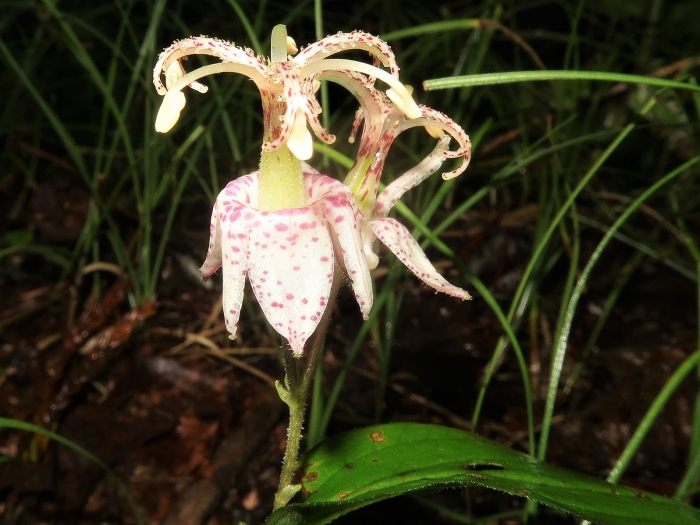Pagoda Toad Lily
(Tricyrtis macropoda)
Pagoda Toad Lily (Tricyrtis macropoda)
/
/

Qwert1234
CC BY-SA 4.0
Image By:
Qwert1234
Recorded By:
Copyright:
CC BY-SA 4.0
Copyright Notice:
Photo by: Qwert1234 | License Type: CC BY-SA 4.0 | License URL: https://creativecommons.org/licenses/by-sa/4.0 | Uploader: Qwert1234 | Publisher: Wikimedia Commons |









Estimated Native Range
Summary
Tricyrtis macropoda, commonly known as Pagoda Toad Lily, is a deciduous perennial herb native to shaded forest floors and moist woodland areas in China, Korea, and Japan. It typically grows to a height of 2-3 feet (0.6-0.9 meters) and a width of 1-2 feet (0.3-0.6 meters). The plant features arching stems and lance-shaped leaves, with unique, orchid-like flowers that are white to pale lilac with heavy spotting and purple markings, blooming in late summer to fall. The flowers are showy and often a highlight in the shade garden.
Pagoda Toad Lily is valued for its exotic-looking flowers and ability to thrive in shaded conditions, making it a popular choice for woodland gardens, shaded borders, and as an underplanting for taller shrubs or trees. It requires consistently moist, well-drained soil rich in organic matter and benefits from a layer of mulch to maintain soil moisture. While it prefers part shade to full shade, it can tolerate morning sun if kept sufficiently moist. It is relatively low maintenance but can be susceptible to slug and snail damage. This plant is not known for aggressive roots or significant disease problems. It is not typically invasive when grown outside its native range, but gardeners should always monitor and manage their plantings responsibly.CC BY-SA 4.0
Pagoda Toad Lily is valued for its exotic-looking flowers and ability to thrive in shaded conditions, making it a popular choice for woodland gardens, shaded borders, and as an underplanting for taller shrubs or trees. It requires consistently moist, well-drained soil rich in organic matter and benefits from a layer of mulch to maintain soil moisture. While it prefers part shade to full shade, it can tolerate morning sun if kept sufficiently moist. It is relatively low maintenance but can be susceptible to slug and snail damage. This plant is not known for aggressive roots or significant disease problems. It is not typically invasive when grown outside its native range, but gardeners should always monitor and manage their plantings responsibly.CC BY-SA 4.0
Plant Description
- Plant Type: Herb
- Height: 2-2.5 feet
- Width: 1-2 feet
- Growth Rate: Moderate
- Flower Color: White, Purple
- Flowering Season: Summer, Fall
- Leaf Retention: Evergreen
Growth Requirements
- Sun: Part Shade, Full Shade
- Water: Medium, High
- Drainage: Slow, Medium
Common Uses
Bird Garden, Edible*Disclaimer: Easyscape's listed plant edibility is for informational use. Always verify the safety and proper identification of any plant before consumption., Groundcover, Hummingbird Garden, Low Maintenance
Natural Habitat
native to shaded forest floors and moist woodland areas in China, Korea, and Japan
Other Names
Common Names: Toad Lily, Vit Skugglilja
Scientific Names: , Tricyrtis macropoda, Tricyrtis macropoda var. macropoda, Compsoa macropoda,
GBIF Accepted Name: Tricyrtis macropoda Miq.